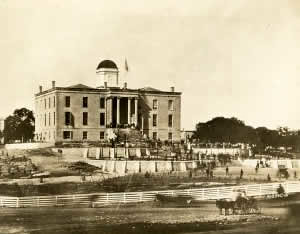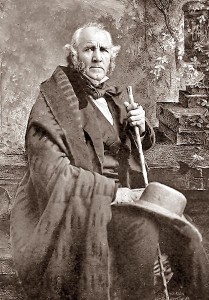Sam Houston’s Last Stand: Part 2
Note: This is part two of Sam Houston’s Last Stand. You can read part one here.

Old Stone Capitol, the Texas Capitol, roughly as it looked during Houston's essential "eviction". Pre-dates the modern day capitol.
The offer had been delivered via Frederick Lander, an adventurer who served with distinction at the start of the war under Army of the Potomac Major General George McClellan, eventually reaching the rank of General. Lander, whose pre-war work as a surveyor for a cross-country railroad made him a prominent and respected military man amongst southern socialites, delivered the offer to Sam Houston from the highest channels of the United States government. It came from Abraham Lincoln himself.
50,000 troops.
50,000 troops to retake the the city of Austin, and more, if need be, to prevent the Texas secession. At that juncture, it remains unclear today if Houston was fully aware that the city even needed to be retaken. Edward Clark, Houston’s Lieutenant Governor, had already taken command from Houston’s very desk at the capitol.
For Houston, the offer from Lincoln and Lander was, at least for a fleeting moment, a tempting one. When successful, Houston could move the Capitol of Texas back east, this time with little-to-no resistance. He would be a virtual dictator in a land of revolutionaries-hated by many of his own people, but adored nationally: The man who stood down Texas from the brink of secession. But Houston had also been through this before, and, unlike so many of his colleagues in Washington, knew that the contest between North and South was going to be a bitter one. Knowing that bloodshed was inevitable, but at that moment he had the choice to wash it from his own hands, Sam Houston hesitantly declined.
Allow me to most respectfully decline any such assistance of the United States Government. - Sam Houston’s couriered reply to Frederick Lander.
The following morning, Sam Houston returned to the Old Stone Capitol. Every morning during his governorship, he brought with him a small container holding his lunch. It was an aesthetic effort on his part — something to personalize him. The lunch container resembled those that the poor grounds people who worked at the Capitol carried. He wanted to give them a sense of equal status, no matter how dim.
That morning, accounts from Capitol workers suggest that Houston’s lunch pal was empty. Instead of carrying his relief from a hard morning’s work in it, he instead would use it to gather his things from the Capitol office, an office occupied by Edward Clark. Accounts suggest that Clark and Houston exchanged a respectful conversation during that brief time, but no accurate historical record of such a conversation exists. Many historians through the years have attempted to piece together the conversation through fictionalizations, but this piece would instead like to leave that to the reader’s imagination.
Part One of “The Voluntary Exile: Sam Houston”
Welcome back to 7th grade history class, people.
Following his removal from office, Sam Houston would make a long trek to Galveston. Along the way, he was met with frequent, disrespectful jeers from onlookers who had heard the news, and the routine question of why he was so ardently opposed to secession. Houston, at a hotel en route to Galveston, delivered his most effective reply to a crowd of bystanders:
Let me tell you what is coming. After the sacrifice of countless millions of treasure and hundreds of thousands of lives, you may win Southern independence if God be not against you, but I doubt it. I tell you that, while I believe with you in the doctrine of states rights, the North is determined to preserve this Union. They are not a fiery, impulsive people as you are, for they live in colder climates. But when they begin to move in a given direction, they move with the steady momentum and perseverance of a mighty avalanche; and what I fear is, they will overwhelm the South.
After spending a year in Galveston, Sam Houston rented a Steambout House in Huntsville, because it reminded him of his native lands of Tennessee. Over time, he has regained his reputation as a part of the very foundation of Texas history, but the decades immediately following the Civil War saw Sam Houston in Texas through a mixed lens. Emotions still high from the failed conflict, there was a definitive sense of bitterness over his sudden, immediate descent in 1861.
During the construction of our modern capitol in the decades proceeding, the Old Stone Capitol briefly served as a storing house for historical records of Texas Governorship. A massive fire at the Old Stone Capitol destroyed many of the contents inside, and because so many of Houston’s counterparts during the time recalled Houston as the man who turned his back on Texas, and not as the man who tried to save it, we have a very incomplete and likely inaccurate portrayal of his later years.
In 1863, Houston contracted pneumonia, and died on July 26th. Just three weeks after Union forces repelled Pickett’s Charge at Gettysburg, and turned the face of the war for the better. No one knows if Sam Houston ever received the news.
.
Want more RoA? Be our friend on Facebook. Add our RSS feed! [what’s that?]. Start your morning withRepublic of Austin in your InBox. Or read us 24-7 on Twitter!
Related posts:
- Sam Houston’s Last Stand: Part 1 In the 1st part of this 2 part series, Matthew...
- You think it’s rained a lot this summer, check out these pics of Austin from the Great Flood of 1935! Austin's had a lot of rain this summer--but nothing compared...
- Texas Capitol: The truth behind the scaffolding, the shocking face of the lady on top and other tidbits. Matthew wonders what the heck those braces on the Capitol...
Related posts brought to you by Yet Another Related Posts Plugin.






Twitter Comment
ROA Sam Houston’s Last Stand: Part 2:
Note: This is part two of Sam Houston’s Last Stand. You ca… [link to post] via @ATX4U
- Posted using Chat Catcher